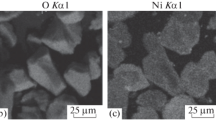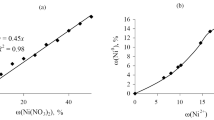Conclusions
-
1.
The chemisorption of O2 on Ni, applied on SiO2, is accompanied both by the oxidation of Ni and by the formation probably of a molecular form of chemisorbed O2.
-
2.
The adsorption of H2 on a surface of Ni entirely covered with oxygen leads to the formation of H2O first according to the Rydil mechanism, and when adsorbed H atoms appear on the freed surface of Ni, according to the Langmuir-Hinshelwood mechanism.
-
3.
The water formed in the first stages of the interaction of H2 with chemisorbed O2 diffuses from the surface of Ni and is chemisorbed on the surface of SiO2. The molecules of H2O formed in subsequent events of interaction are also adsorbed on the surface of SiO2 but are readily desorbed from it at room temperature.
Similar content being viewed by others
Literature cited
D. Eli, in: Catalysis. Problems of Theory and Methods of Investigation [Russian translation], IL (1955), p. 188; O. Bak, Ibid., p. 229.
V. Ponets, in: Problems of Kinetics and Catalysis [in Russian], Vol. 14, Nauka (1970), p. 10.
Z. Knor, Advances in Catalysis,22, 51 (1972).
E. Rydil, The Development of Concepts in the Field of Catalysis [Russian translation], Mir (1971), p. 118.
A. A. Slinkin, A. V. Kucherov, and A. M. Rubinshtein, Izv. Akad. Nauk SSSR, Ser. Khim., 12 (1975).
I. A. Lavrov, A. A. Slinkin, M. I. Loktev, V. S. Polyakov, and A. D. Osipov, Kinetika i Kataliz,12, 1587 (1971); M. I. Loktev, Dissertation [in Russian], Moscow (1971).
J. W. Geus and A. P. P. Nobel, J. Catalysis,6, 108 (1966); J. W. Geus, A. P. P. Nobel, and H. Schutte, J. Coll. Interface Sci.,26, 266 (1968).
Z. Oda. Bull. Chem. Soc., Japan,27, 465 (1954).
N. Scheuble, Z. Phys.,135, 125 (1953).
O. Beeck, A. E. Smith, and A. Wheeler, Proc. Boy. Soc., A177, 62 (1940).
G. D. Lyubarskii, N. V. Kul'kova, R. Kh. Burshtein, G. G. Isaeva, L. N. Ivanovskaya, and N. A. Shurmovskaya, Dokl. Akad. Nauk SSSB,140, 634 (1961).
J. J. Broeder, L. L. Van Reijen, W. M. H. Sachtler, and G. C. A. Schut, Z. Elektrochem.,60, 838 (1956); Khimiya i Khim. Tekhnologiya, No. 8, 174 (1957).
A. A. Slinkin, M. I. Loktev, and A. M. Rubinshtein, Dokl. Akad. Nauk SSSR,207, 1169 (1972).
Author information
Authors and Affiliations
Additional information
Translated from Izvestiya Akademii Nauk SSSR, Seriya Khimicheskaya, No. 1, pp. 17–24, January, 1975.
Rights and permissions
About this article
Cite this article
Slinkin, A.A., Kucherov, A.V. & Rubinshtein, A.M. Interaction of hydrogen and oxygen on the surface of Ni-SiO2 catalysts. Russ Chem Bull 24, 10–16 (1975). https://doi.org/10.1007/BF00926282
Received:
Issue Date:
DOI: https://doi.org/10.1007/BF00926282




